The Glasgow Coma Scale (GCS) allows healthcare professionals to consistently evaluate the level of consciousness of a patient It is commonly used in the context of head trauma, but it is also useful in a wide variety of other nontrauma related settings Regular assessment of a patient's GCS can identify early signs of deteriorationIn 17, Salmani et al published a threegroup doubleblinded randomized controlled trial including 90 consecutive comatose patients with traumatic brain injuries and a GCS score of 58 to evaluate the effects of familycentered affective stimulation on the level of consciousnessThe Glasgow Coma Scale is an adopted standard for assessment of impaired consciousness and coma in the acutely ill trauma and nontrauma patient and assists with predictions of neurological outcomes (complications, impaired recovery) and mortality Best eye response

New Glasgow Coma Scale Pupils Score And Multifactor Probability Outcome Charts For Use In Patients With Tbi
Comatose patient gcs
Comatose patient gcs-The Glasgow Coma Scale (GCS) is a neurological evaluation tool that physicians use to evaluate the level of consciousness of a person with brain damage It allows us to explore or quantify three parameters or criteria for observation They are 1) eye response, 2) verbal response, and 3) motor response The Glasgow Coma Scale is the most used tool in hospital and prehospital environmentsThe Glasgow Coma Scale (GCS) has been the gold standard for assessing the level of consciousness in patients with significant brain injury Prior efforts to modify or replace this scale have been unsuccessful because no scale could improve on its simplicity and practical usefulness This review prov
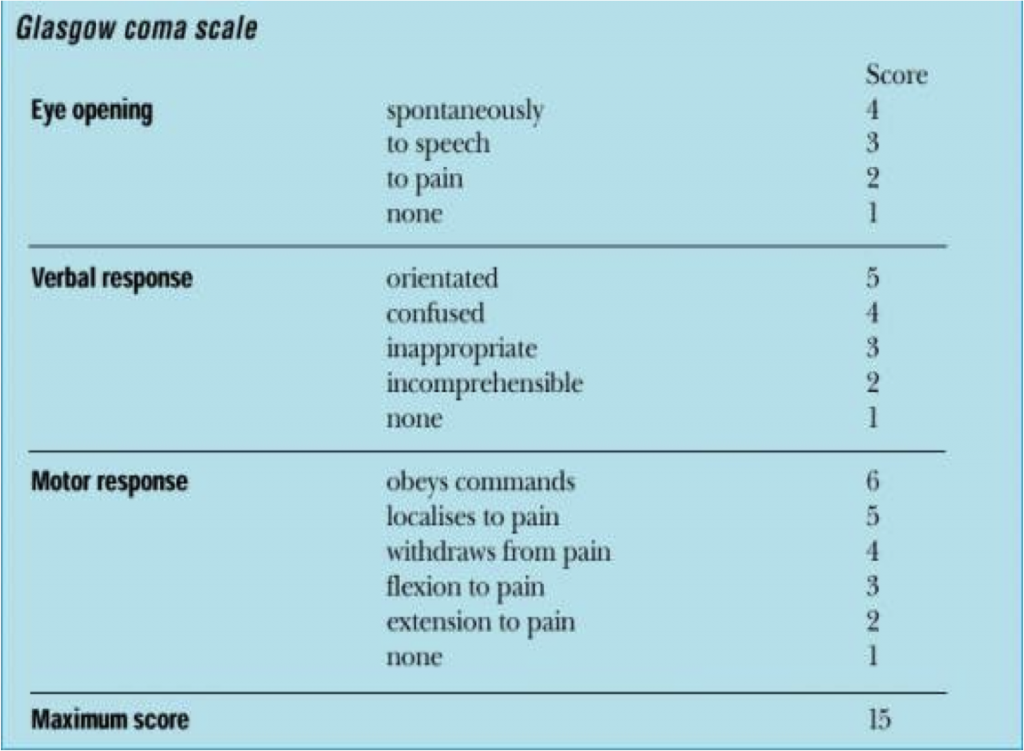


How To Calculate A Glasgow Coma Scale Gcs Score First Aid For Free
The Glasgow Coma Scale (GCS) 3,4 is a widelyused instrument to assess consciousness at the site of injury, in emergency departments, and in hospitals to monitor progress or deterioration during treatment 5 The GCS consists of three categories of responses eye, verbal, and motorAnd does not initiate voluntary actions Coma patients exhibit a complete absence of wakefulness and are unable to consciously feel, speak or move Comas can be derived by natural causes, or can be medicallyThe Glasgow Coma Scale (GCS) allows physicians to quickly and easily communicate the severity of a patient's head injury in the first hours or days after the trauma It is therefore often used to follow the condition of the patient in the first several days in the hospital Additionally, the GCS is a good prognostic indicator
• A modified GCS is required for paediatric patient • The application of a painful stimulus by a clinician during the assessment of an February, 21 Figure 3 31 The Glasgow Coma Scale (GCS) was first introduced in 1974 as a measure of conscious level in the setting of traumatic brain injury Its ease ofThe Glasgow coma scale (GCS) is a tool used to assess and calculate a patient's level of consciousness It was developed more than 40 years ago by two neurosurgeons in Glasgow and is widely applied today1 The GCS uses a triple criteria scoring system best eye opening (maximum 4 points), best verbal response (maximum 5 points), and best motor response (maximum 6 points)Glasgow Coma Scale (GCS) The GCS is used across the world and is a means of scoring a patient's conscious level It is also useful to monitor progress of the patient The GCS is determined by assessing three aspects eye opening (four levels), verbal response (five levels) and motor response (six levels)
Definition The GCS is the summation of scores for eye, verbal, and motor responses The minimum score is a 3 which indicates deep coma or a braindead state The maximum is 15 which indicates a fully awake patient (the original maximum was 14, but the score has since been modified) For best eye responses, there are 4 possible scores No eye openingLacks a normal wakesleep cycle;Fails to respond normally to painful stimuli, light, or sound;



Using The Glasgow Coma Scale



Management And Evaluation Of The Comatose Patient Ppt Video Online Download
GLASGOW COMA SCALE – Purpose, Description of the GCS, Equipment, Procedure, Eye Open, Best Motor Response, Verbal Response and InterpretationDefinition The GCS is the summation of scores for eye, verbal, and motor responses The minimum score is a 3 which indicates deep coma or a braindead state The maximum is 15 which indicates a fully awake patient (the original maximum was 14, but the score has since been modified)GLASGOW COMA SCALE – Purpose, Description of the GCS, Equipment, Procedure, Eye Open, Best Motor Response, Verbal Response and Interpretation



Gcs Remastered Recent Updates To The Glasgow Coma Scale Gcs P Emottawa



How To Calculate A Glasgow Coma Scale Gcs Score First Aid For Free
There are a few different systems that medical practitioners use to diagnose the symptoms of Traumatic Brain Injury This section discusses the Glasgow Coma Scale Click on the link to find out more information about the Ranchos Los Amigos Scale The Glasgow Coma Scale is based on a 15point scale for estimating and categorizing the outcomes of brain injury on the basis of overall social capability or dependence on othersBackground The Glasgow Coma Scale (GCS) score has been adapted into categories of severity (mild, moderate, and severe) and are ubiquitous in the trauma setting This study sought to revise the GCS categories to account for an interaction by age and to determine the discrimination of the revised categories compared with the standard GCS categoriesComa No eye opening, no ability to follow commands, no word verbalizations (38) Head Injury Classification Severe Head InjuryGCS score of 8 or less Moderate Head InjuryGCS score of 9 to 12 Mild Head InjuryGCS score of 13 to 15 (Adapted from Advanced Trauma Life Support Course for Physicians, American College of Surgeons, 1993)
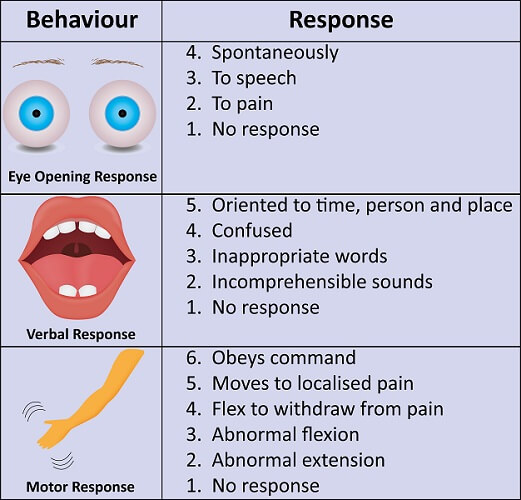


Glasgow Coma Scale The Definitive Guide Biology Dictionary



Test Question Glasgow Coma Scale Med Made Ez Mme
The Glasgow Coma Scale (GCS) allows healthcare professionals to consistently evaluate the level of consciousness of a patient It is commonly used in the context of head trauma, but it is also useful in a wide variety of other nontrauma related settings Regular assessment of a patient's GCS can identify early signs of deteriorationThe Glasgow coma scale (GCS) is a tool used to assess and calculate a patient's level of consciousnessThe Glasgow coma score (GCS) during days 16 after cardiac arrest was used to predict neurological outcome in 360 resuscitated victims of outofhospital cardiac arrest A predictive rule based on the best GCS of 216 patients resuscitated in 1984 (prediction group) was constructed, and its predictive power was tested on 133 patients treated



Glasgow Coma Scale Adult And Pediatric From International Trauma Life Support Itls Tom Wade Md



Neurological Examination Of A Comatose Patient Gcs Glasgow Coma Scale Download Scientific Diagram
The Glasgow coma scale (GCS) is a tool used to assess and calculate a patient's level of consciousness It was developed more than 40 years ago by two neurosurgeons in Glasgow and is widely applied today1 The GCS uses a triple criteria scoring system best eye opening (maximum 4 points), best verbal response (maximum 5 points), and best motor response (maximum 6 points)A patient with a GCS of 3 is considered comatose, while a GCS of 15 would be an alert, oriented, conscious person Real quick I want you to know the difference between abnormal flexion and abnormal extension When a patient doesn't follow commands, we administer some sort of noxious or painful stimulus to see how they respondGLASGOW COMA SCALE The Glasgow Coma Scale has proved a practical and consistent means of monitoring the state of head injured patients In the acute stage, changes in conscious level provide the best indication of the development of complications such as intracranial haematoma whilst the depth of coma and its duration indicate the degree of



Cdumevylr373mm



The Glasgow Coma Scale At 40 Years Standing The Test Of Time The Lancet Neurology
The Glasgow Coma Scale (GCS), designed in 1974, is a tool that has the ability to communicate the level of consciousness of patients with acute or traumatic brain injury Developed by Graham Teasdale and Bryan J Jennett, professors of neurosurgery at the University of Glasgow's Institute of Neurological Sciences, this scale is the gold standard used for all acute medical and trauma patientsGlasgow Coma Scale Teasdale and Jennett published the Glasgow Coma Scale (GCS) in the Lancet in 1974 as an aid in the clinical assessment of posttraumatic unconsciousness It was devised as a formal scheme to overcome the ambiguities that arose when information about comatose patients was presented and groups of patients compared The GCS hasThe objective of this study is to determine association between DV and Glasgow Coma Score (GCS), for patients with acquired brain injury Methods There were 2,8 patients with acquired brain injury, pupillometer readings, and daily GCS values available in our registry GCS was trichotomized as severe (GCS ≤ 8), moderate (GCS = 912), or mild injury (GCS = 1315)



What Is A Normal Gcs Score



Gcs Remastered Recent Updates To The Glasgow Coma Scale Gcs P Emottawa
Glasgow Coma Scale The Glasgow Coma Scale provides a practical method for assessment of impairment of conscious level in response to defined stimuli "The Glasgow Coma Scale is an integral part of clinical practice and research across the World The experience gained since it was first described in 1974 has advanced the assessment of the Scale through the development of a modern structured approach with improved accuracy, reliability, and communication in its use"The GCS for a dead person would be 3 Certain scores on the Glasgow Coma Scale have significance Patients with a Glasgow Coma Scale score of 7 or less are considered comatose Patients with a Glasgow Coma Scale score of 8 or less are considered to have suffered a severe head injury Glascow Coma Scale Test Best Score Patient's Response Eye OpeningReith FC, Lingsma HF, Gabbe BJ, Lecky FE, Roberts I, Maas AIR Differential effects of the Glasgow Coma Scale Score and its Components An analysis of 54,069 patients with traumatic brain injury Injury 17;48(9) Reith FC, Van den brande R, Synnot A, Gruen R, Maas AI The reliability of the Glasgow Coma Scale a systematic review



Glasgow Coma Scale Download Table



Glasgow Coma Scale Flow Chart A Beginner S Guide British Journal Of Nursing
GCS 3 Completely unresponsive Total coma There are a lot of test questions that really just want to know if you understand that 3 is the bottom GCS 15 Almost all (73% of patients) are GCS 15 You can practice saying this on all normal patients Patient opens eyes, speech is fine, and moves on his own GCS 14 The patient is confused This is another very common one to have on handThe Glasgow Coma Scale is a clinical scale used to reliably measure a person's level of consciousness after a brain injury The GCS assesses a person based on their ability to perform eye movements, speak, and move their body These three behaviors make up the three elements of the scale eye, verbal, and motor A person's GCS score can range from 3 to 15 This score is used to guide immediate medical care after a brain injury and also to monitor hospitalized patients and track their level of coThe level of coma as measured on the Glasgow coma scale is predictive of outcome Even after six hours of coma it is apparent that patients with higher levels in the hierarchical scale have a better outcome (table 2) Within six hours of coma onset those patients who show eye opening have almost a one in five chance of achieving a good recovery whereas those who do not have a one in 10 chance


Full Outline Of Un Responsiveness Scale Four Versus Modified Glasgow Coma Scale Gcs In Predicting Discharge Outcomes Of Altered Consciousness Patients



40 Years Of The Glasgow Coma Scale Openlearn Open University
In the initial care of a comatose patient, chronologically, there may be first responders, emergency medical technicians (EMTs), paramedics, nurses, emergency physicians, neurologists, and neurosurgeons, all evaluating the same patient in different places at different times The Glasgow Coma Scale allows a standard assessment that can be sharedA coma is a deep state of prolonged unconsciousness in which a person cannot be awakened;You'll be tempted to mark zero Remember, the lower limit of GCS is 3, not 0 The mnemonic for eye opening response are in the numbers itself (See image)



Glasgow Coma Scale Explained The Bmj
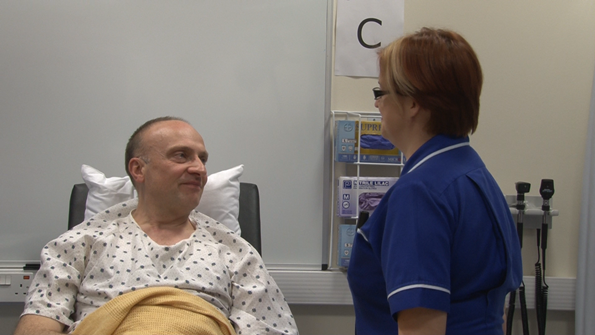


Rlo Assessment Of A Patient S Level Of Consciousness
This post is on the Glasgow Coma Scale (GCS) An important MCQ they like asking is that if the patient doesn't respond to pain, doesn't open his eyes and doesn't talk What is the GCS?The Glasgow Coma Scale (GCS) has positioned itself as a major prognostic marker for outcome in comatose patients The recent introduction of a more detailed scale—the Full Outline of Unresponsiveness (FOUR) score—has provided the opportunity to analyze its predictive value and compare it to GCS as the current standardBackground The Glasgow Coma Scale (GCS) score has been adapted into categories of severity (mild, moderate, and severe) and are ubiquitous in the trauma setting This study sought to revise the GCS categories to account for an interaction by age and to determine the discrimination of the revised categories compared with the standard GCS categories



Glasgow Coma Scale How To Perform The Assessment
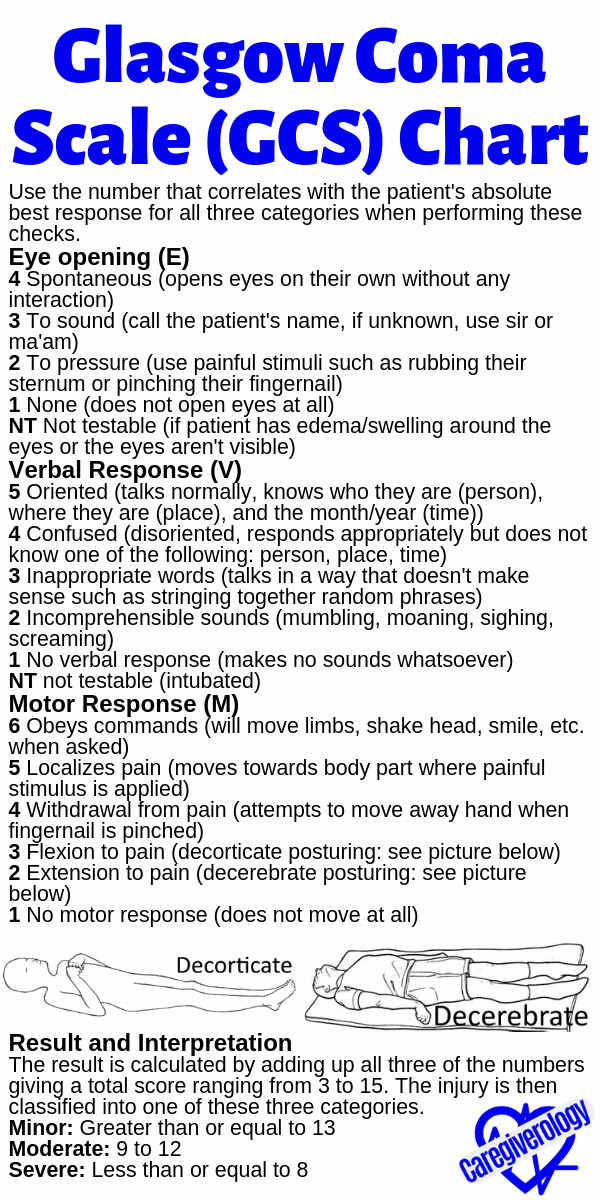


Glasgow Coma Scale Gcs Explained In Detail Caregiverology
• A modified GCS is required for paediatric patient • The application of a painful stimulus by a clinician during the assessment of an February, 21 Figure 3 31 The Glasgow Coma Scale (GCS) was first introduced in 1974 as a measure of conscious level in the setting of traumatic brain injury Its ease ofAnd meningitis The GCS is additionally an free indicator of survival within the common basically sick populace and has been consolidated into a number of broadly utilized prognostic seriously care scoring frameworks Computed Tomography (CT) of the brain is justified in essentially all patients with an intense onset of unexplained comaComa No eye opening, no ability to follow commands, no word verbalizations (38) Head Injury Classification Severe Head InjuryGCS score of 8 or less Moderate Head InjuryGCS score of 9 to 12 Mild Head InjuryGCS score of 13 to 15 (Adapted from Advanced Trauma Life Support Course for Physicians, American College of Surgeons, 1993)



Glasgow Coma Scale Gcs Assessment Youtube



Image Result For Gcs Score In Intubated Patients Glasgow Coma Scale Brain Injury Nursing Mnemonics
There are many different assessment tools for neurological function, however, the most widely known and used tool is the Glasgow Coma Scale (GCS) The patient is assessed and scored in three areas Eye opening;The Glasgow Coma Scale (GCS) has been the gold standard for assessing the level of consciousness in patients with significant brain injury Prior efforts to modify or replace this scale have been unsuccessful because no scale could improve on its simplicity and practical usefulnessGLASGOW COMA SCALE – Purpose, Description of the GCS, Equipment, Procedure, Eye Open, Best Motor Response, Verbal Response and Interpretation



Glasgow Coma Scale Medictests



Glasgow Coma Scale Explained The Bmj
The Glasgow Coma Scale was described in 1974 by Graham Teasdale and Bryan Jennett as a way to communicate about the level of consciousness of patients with an acute brain injuryThe Glasgow Coma Scale (GCS) is the most common scoring system used to describe the level of consciousness in a person following a traumatic brain injury Basically, it is used to help gauge the severity of an acute brain injury The test is simple, reliable, and correlates well with outcome following severe brain injuryThe Glasgow Coma Scale (GCS) was developed to overcome the misunderstandings and confusion about comatose patients The GCS is also used to assess neurological trauma as well as to document and predict neurological changes It is considered the gold standard in this regard and is widely used



The Estimated Verbal Gcs Subscore In Intubated Traumatic Brain Injury Patients Is It Really Better Abstract Europe Pmc



Gcs 40 Glasgow Coma Scale Updates Standardize Stimulation Response
The Glasgow Coma Scale (GCS) can be used to assess the severity of brain damage following a head injury It gives patients a score, according to verbal responses, physical responses, and how easilyThe Glasgow coma score (GCS) during days 16 after cardiac arrest was used to predict neurological outcome in 360 resuscitated victims of outofhospital cardiac arrest A predictive rule based on the best GCS of 216 patients resuscitated in 1984 (prediction group) was constructed, and its predictive power was tested on 133 patients treated



Glasgow Coma Scale Gcs Ausmed Explains Youtube
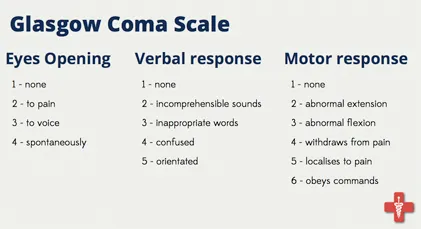


Understanding The Glasgow Coma Scale Swope Rodante P A



Glasgow Coma Scale Physiopedia



Bvns Neurotransmitter 2 0 Technically Speaking September 16 Bush Veterinary Neurology Service



Coma Scales Veterian Key



Glasgow Coma Scale Gcs Horizontal Badge Card



Full Text Delirium After A Traumatic Brain Injury Predictors And Symptom Patter Ndt



New Glasgow Coma Scale Pupils Score And Multifactor Probability Outcome Charts For Use In Patients With Tbi



Glasgow Coma Scale For Field Triage Of Trauma A Systematic Review Ncbi Bookshelf



Coma Scale Glasgow Coma Scale Glasgow Coma Scale Interpretation
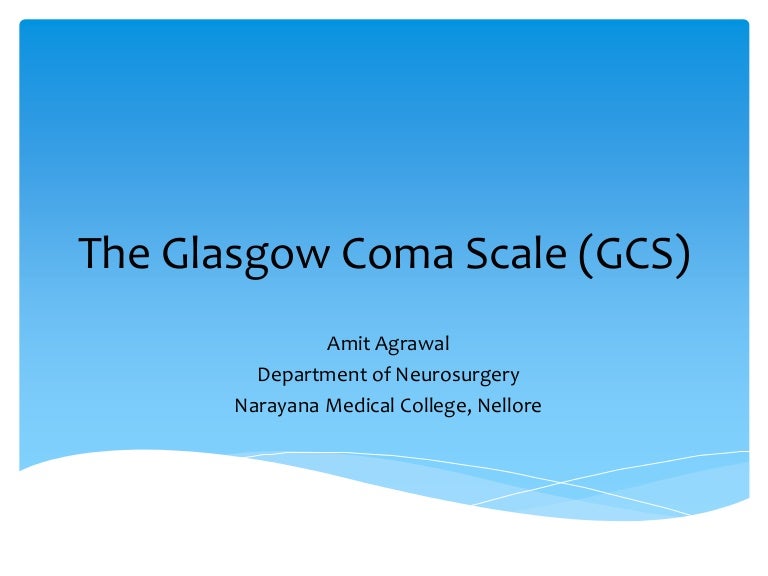


The Glasgow Coma Scale Gcs
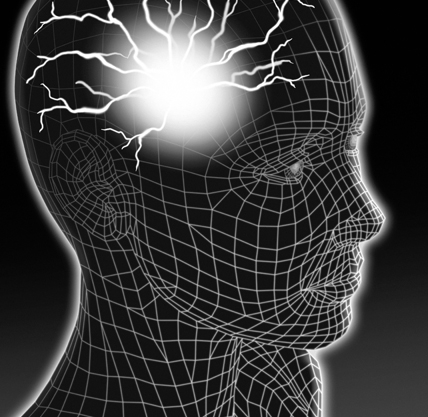


What Is The Glasgow Coma Scale Brainline



A Comparison Of The Glasgow Coma Scale Score With Full Outline Of Unresponsiveness Scale To Predict Patients Traumatic Brain Injury Outcomes In Intensive Care Units Topic Of Research Paper In Clinical



Glasgow Coma Scale Medictests
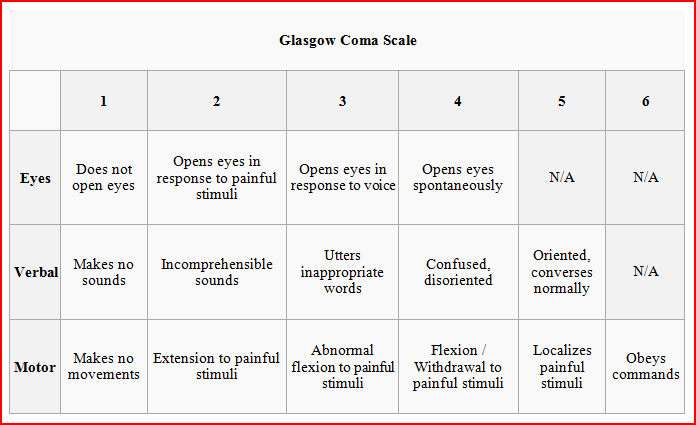


Dacota Manual English Glasgow Coma Scale On Scene



What Is The Glasgow Coma Scale Rosenberg Gluck Llp



Glasgow Coma Scale Coding In Icd 10 Cm Change For Fy 21 Medical Coding Buff



Glasgow Coma Scale Gcs Made Easy Nursemathmedblog
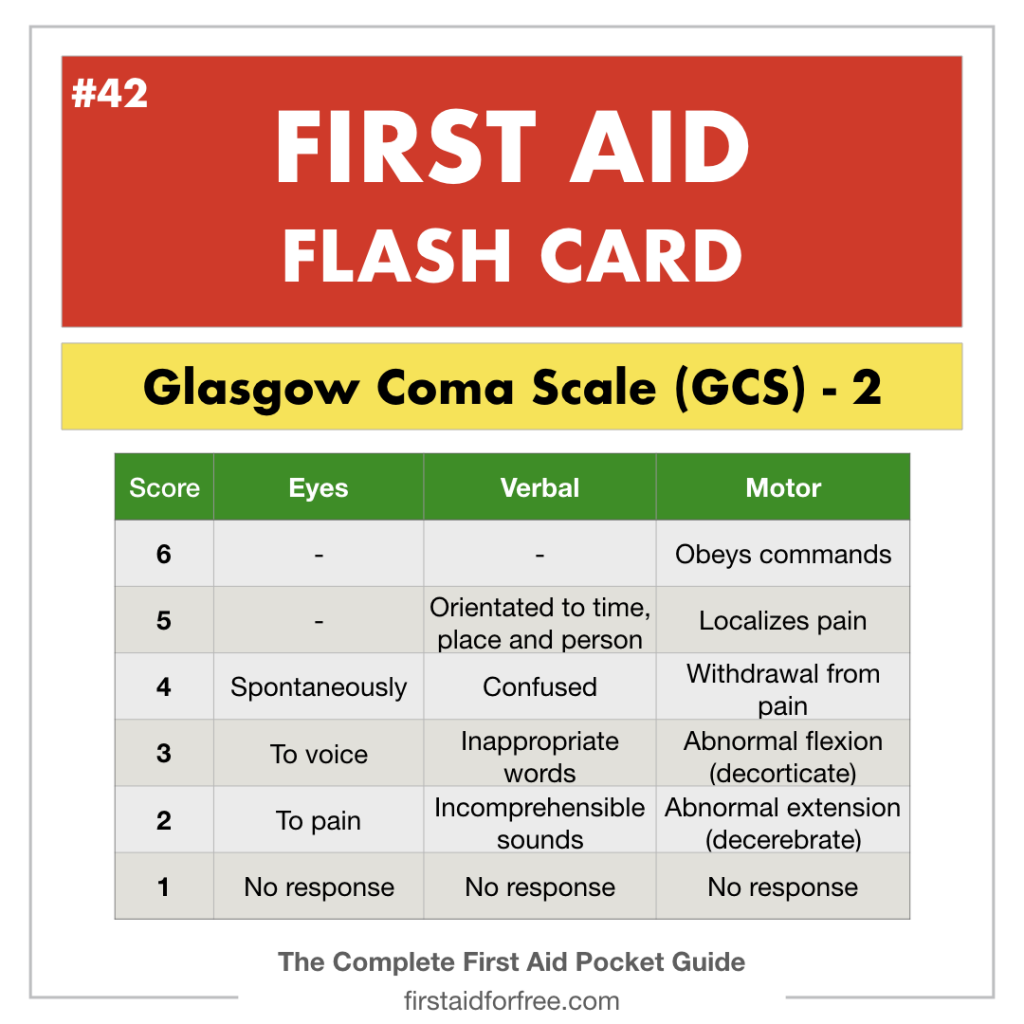


The Glasgow Coma Scale Gcs For First Aiders First Aid For Free



Amazon Com Glasgow Coma Scale Gcs Vertical Reference Badge Id Card 1 Card Health Personal Care
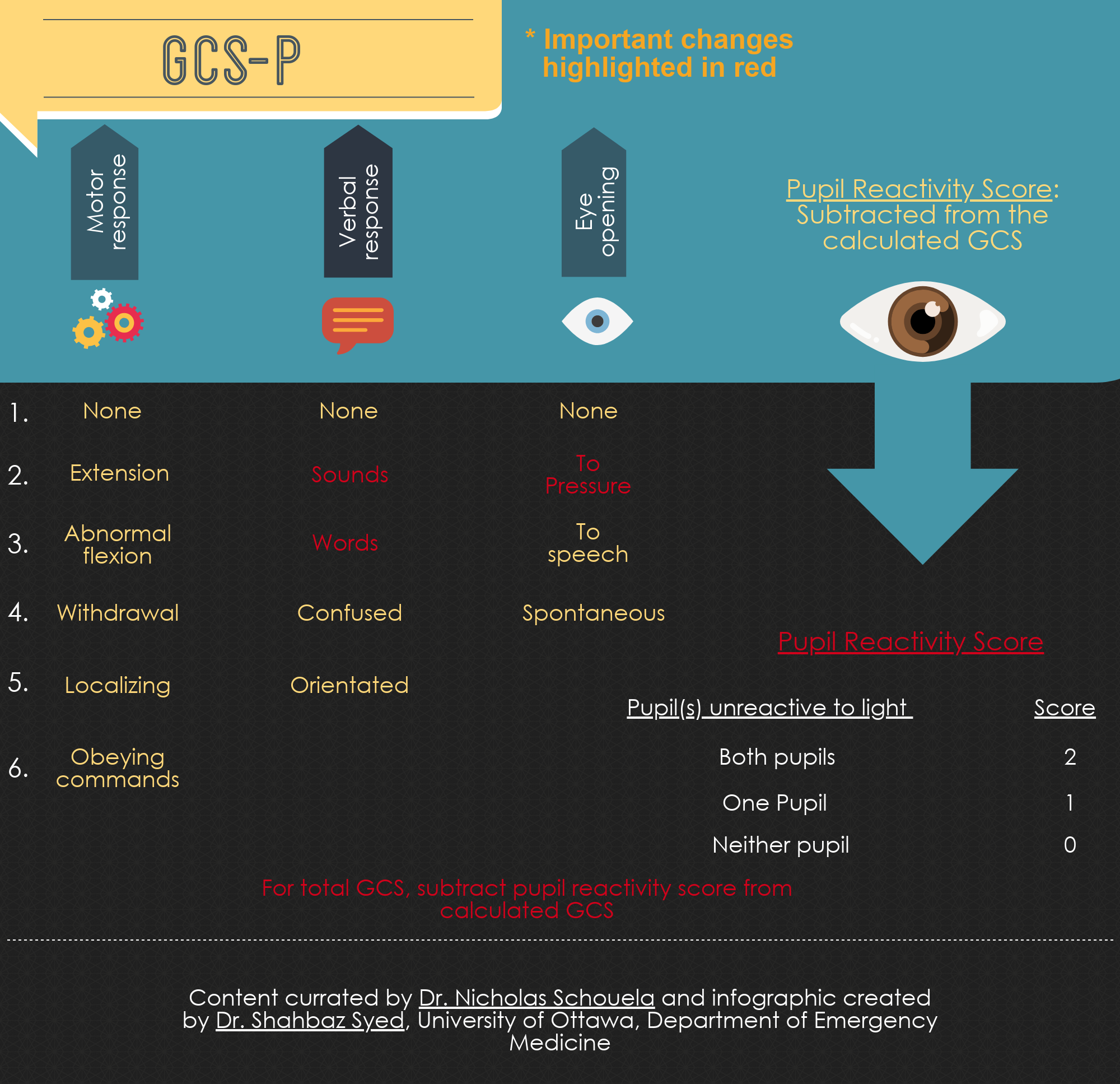


Gcs Remastered Recent Updates To The Glasgow Coma Scale Gcs P Emottawa



The Glasgow Coma Scale Gcs For First Aiders Emt Study Glasgow Coma Scale Nbcot Exam



Glasgow Coma Scale Adult And Pediatrics Check On Grepmed



Glasgow Coma Scale Stock Photo Picture And Royalty Free Image Image
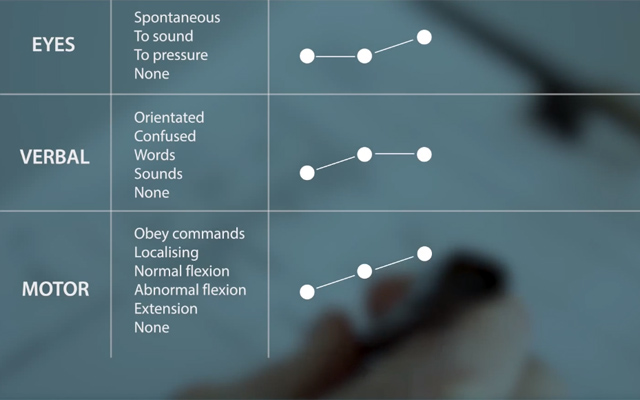


Glasgow Coma Scale
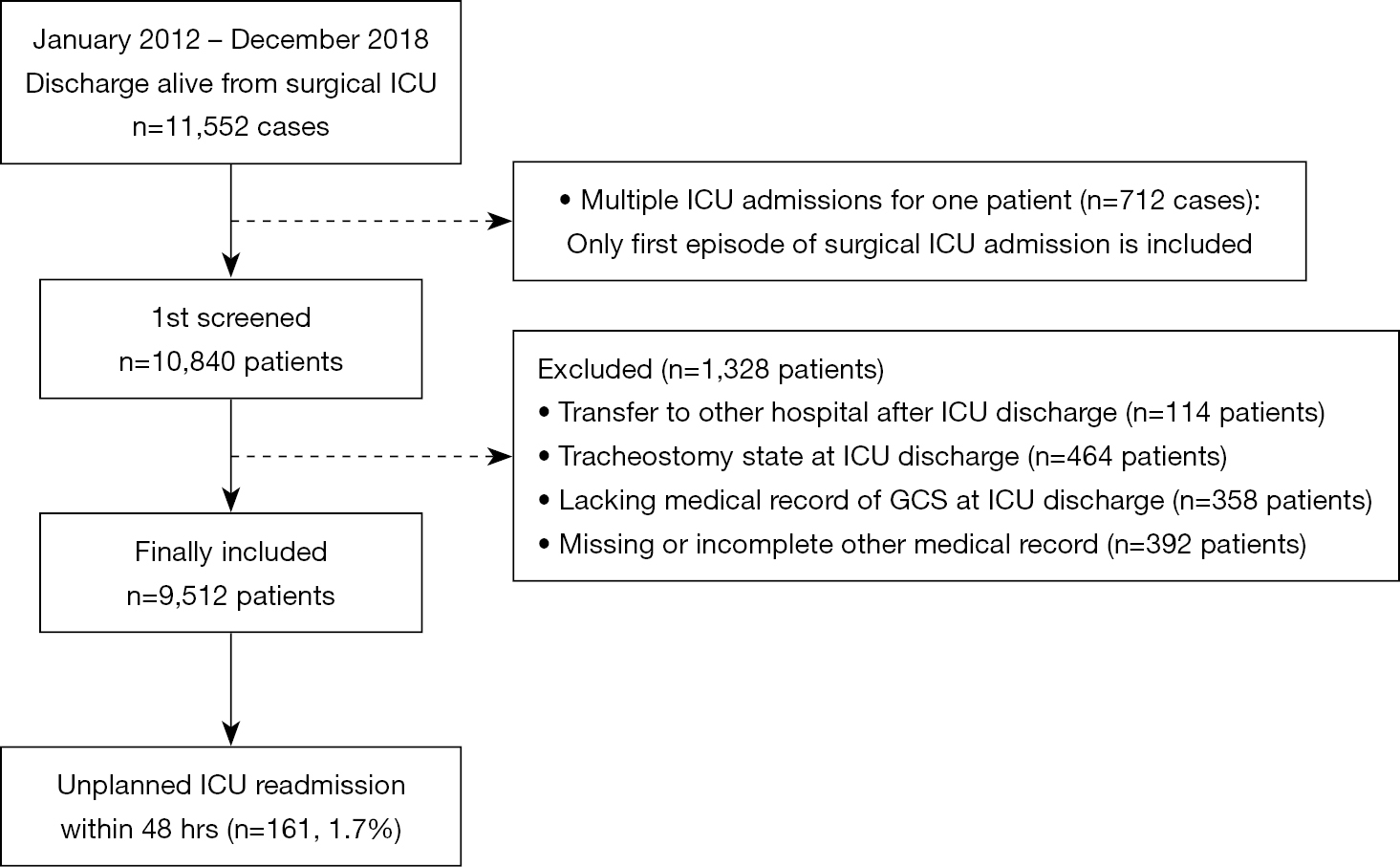


Impact Of Glasgow Coma Scale Scores On Unplanned Intensive Care Unit Readmissions Among Surgical Patients Oh Annals Of Translational Medicine


In Hospital Mortality And The Glasgow Coma Scale In The First 72 Hours After Traumatic Brain Injury



The Glasgow Coma Scale In Adults Doing It Right



Using The Four Score Scale To Assess Comatose Patients American Nurse



Glasgow Coma Scale Gcs How To Assess Gcs Geeky Medics



The Glasgow Coma Scale At 40 Years Standing The Test Of Time The Lancet Neurology
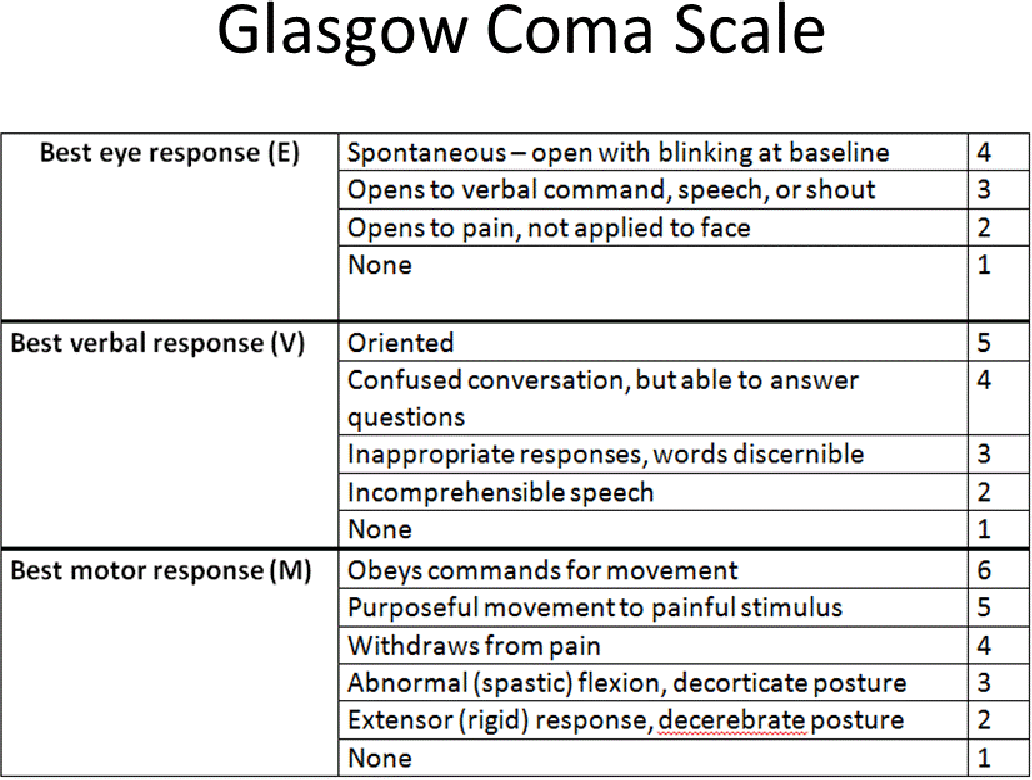


Nurses Knowledge And Practice In The Application Of The Glasgow Coma Scale In The Intensive Care Units And Emergency Department At Muhimbili National Hospital And Muhimbili Orthopaedic Institute In Dar Es Salaam



Gcs Remastered Recent Updates To The Glasgow Coma Scale Gcs P Emottawa



Measuring Brain Injury Severity With The Glasgow Coma Scale Law Office Of Kevin J Mcmanus



Ems Recap The Glasgow Coma Scale Ems World
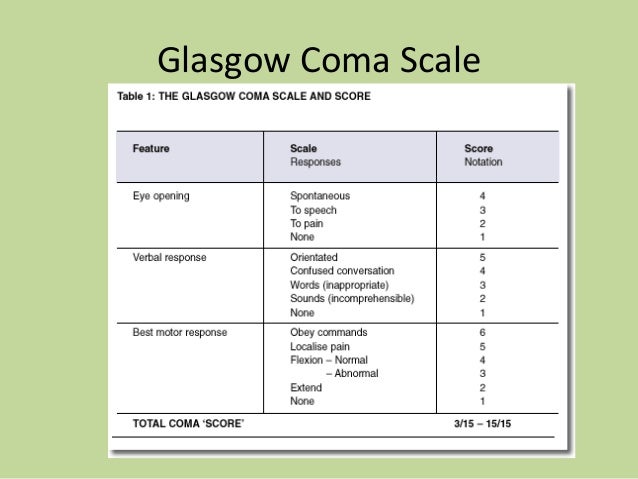


Assessment Of An Unconscious Comatose Patient



The Glasgow Coma Scale In Adults Doing It Right
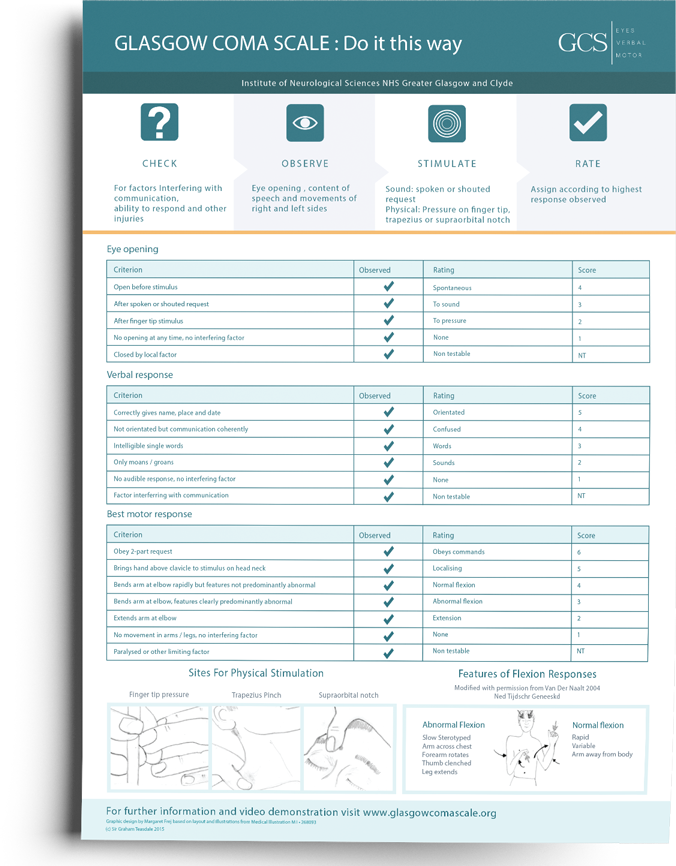


Glasgow Coma Scale



Glasgow Coma Scale Coding In Icd 10 Cm Change For Fy 21 Medical Coding Buff



Glasgow Coma Scale Adult And Pediatric From International Trauma Life Support Itls Tom Wade Md



Percentage Of Patients With Ich By Age And Glasgow Coma Scale Gcs Severity Categories In Relation To Gender At Admission
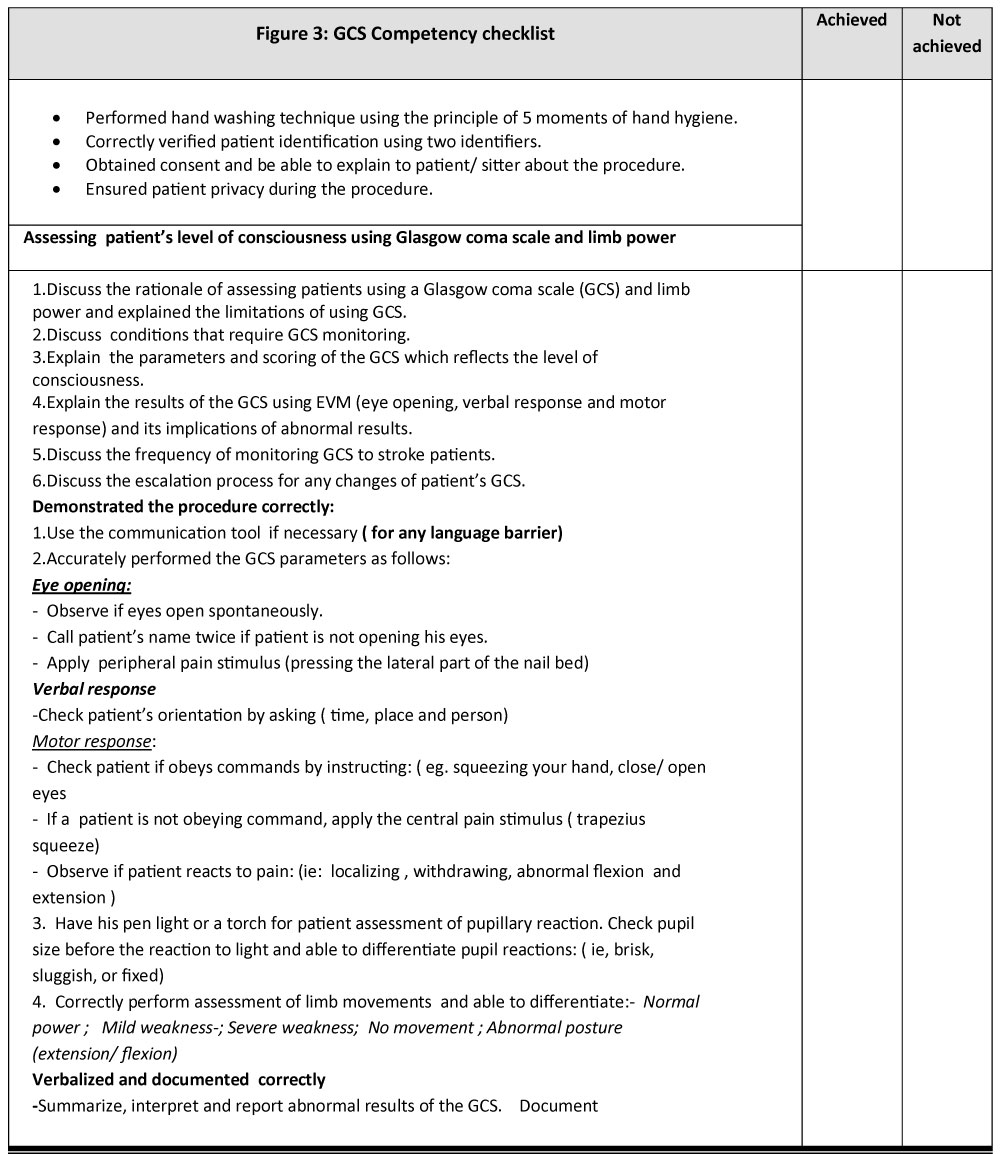


Improving Glasgow Coma Scale Gcs Competency Of Nurses In One Acute Stroke Unit A Nursing Initiative Project



Impact Of Glasgow Coma Scale Scores On Unplanned Intensive Care Unit Readmissions Among Surgical Patients Oh Annals Of Translational Medicine
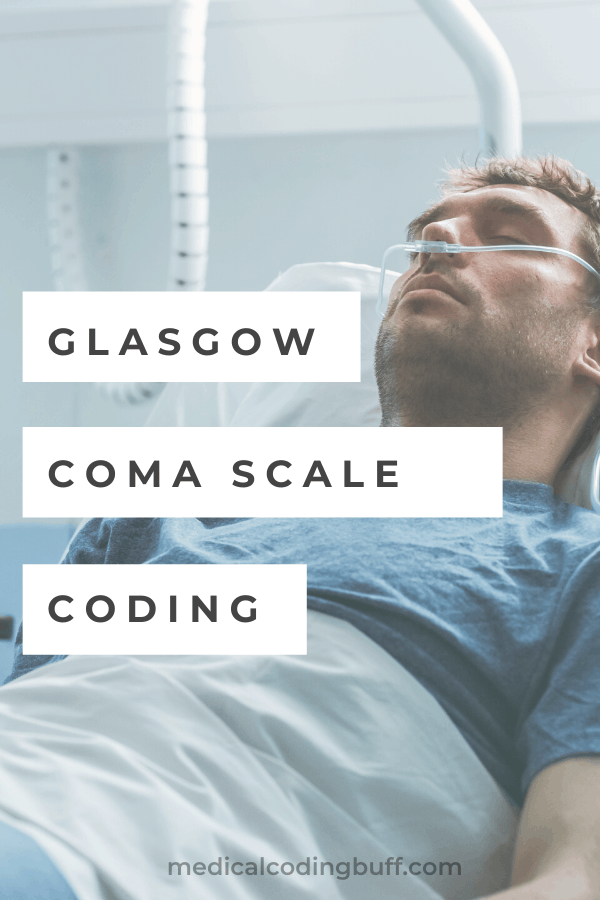


Glasgow Coma Scale Coding In Icd 10 Cm Change For Fy 21 Medical Coding Buff



Reliability Of Glasgow Coma Score In Pediatric Trauma Patients Journal Of Pediatric Surgery
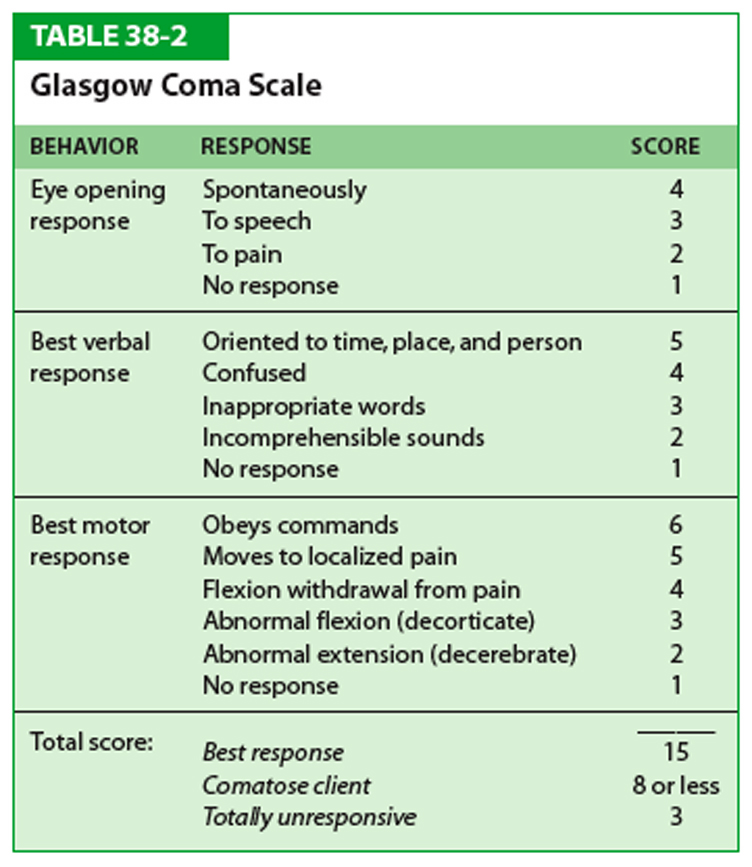


The Glasgow Coma Scale Gcs For First Aiders First Aid For Free



Keep It Simple Acute Gcs Score As A Binary Decision Urgent Matters



Rapid Id Glasgow Coma Scale Pain Scale



A Practical Method For Dealing With Missing Glasgow Coma Scale Verbal Component Scores In Journal Of Neurosurgery Ahead Of Print



Practical Aspects Of Performing Glasgow Coma Scale Observations
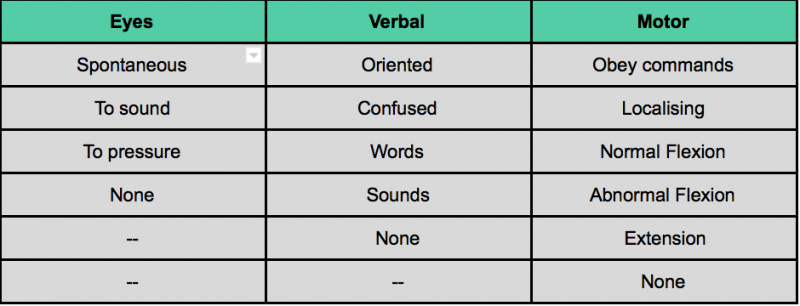


Glasgow Coma Scale Physiopedia
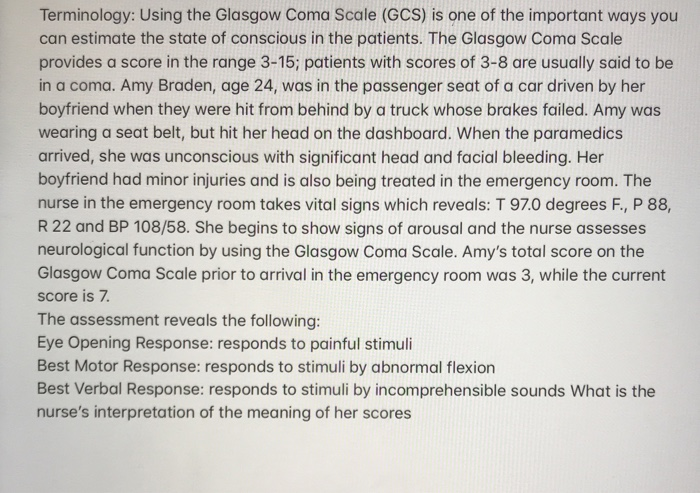


Solved Terminology Using The Glasgow Coma Scale Gcs Is Chegg Com



Gcs Score Glascow Coma Scale And Blantyre Score Assessment And Interpretation Jotscroll



The Glasgow Coma Scale And Other Neurological Observations Semantic Scholar
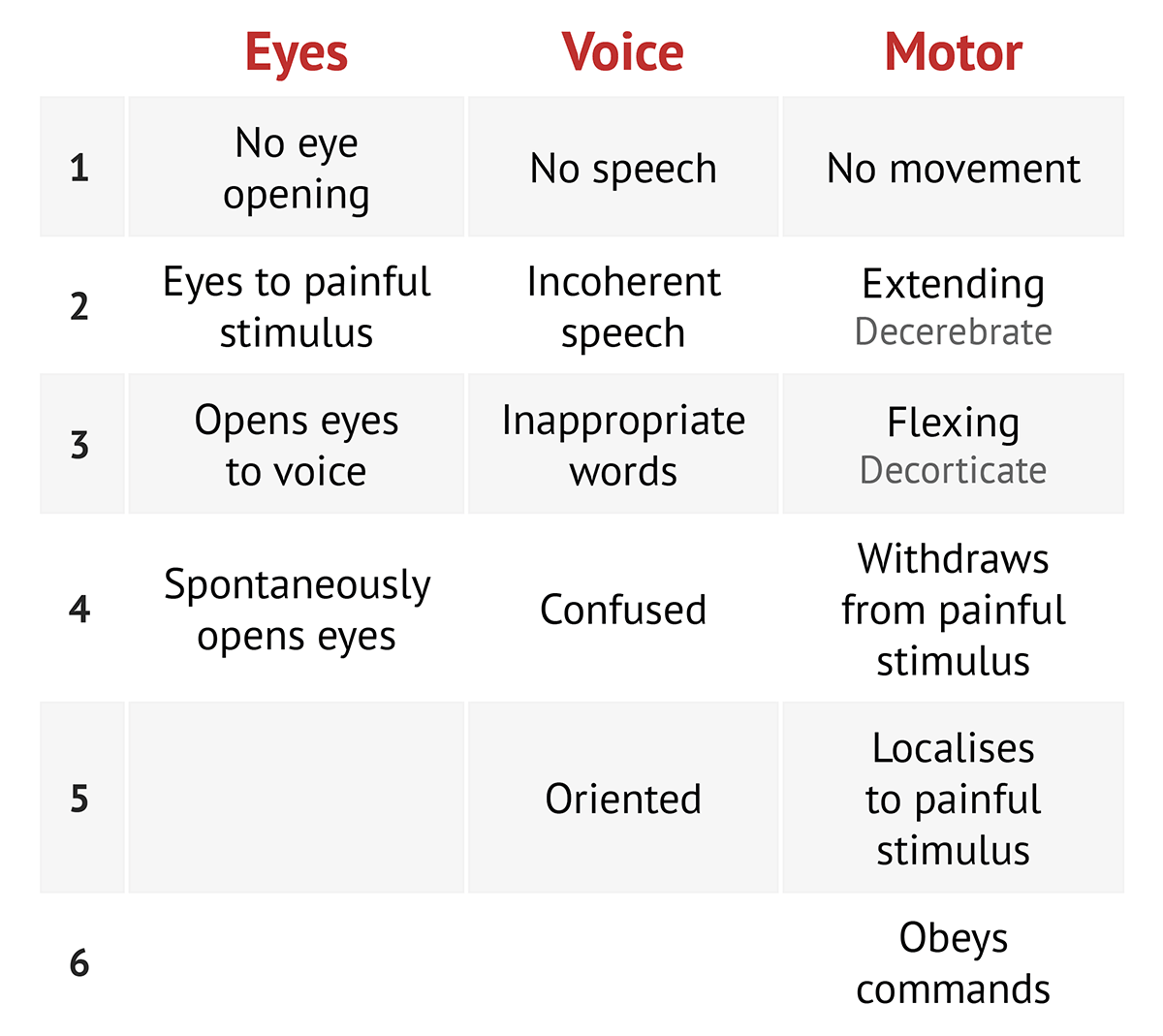


Reduced Glasgow Coma Scale Signs Medschool



Neurological Examination Of A Comatose Patient Gcs Glasgow Coma Scale Download Scientific Diagram



New Glasgow Coma Scale Pupils Score And Multifactor Probability Outcome Charts For Use In Patients With Tbi



Glasgow Coma Scale Are You Ok The Scrub Nurse



Glasgow Coma Scale Explained The Bmj



Pdf The Glasgow Coma Scale In Adults Doing It Right



Glasgow Coma Scale Explained The Bmj



Traumatic Brain Injury Glasgow Coma Scale


Coma Scales A Historical Review



The Ed Approach To The Comatose Patient Nuem Blog



Glasgow Coma Scale The Definitive Guide Biology Dictionary



Glasgow Coma Scale Are You Ok The Scrub Nurse



How To Assess Glasgow Coma Scale Gcs In Adults And Children Intensive Care Hotline



Understanding The Pediatric Glasgow Coma Scale Rainbow Rehabilitation
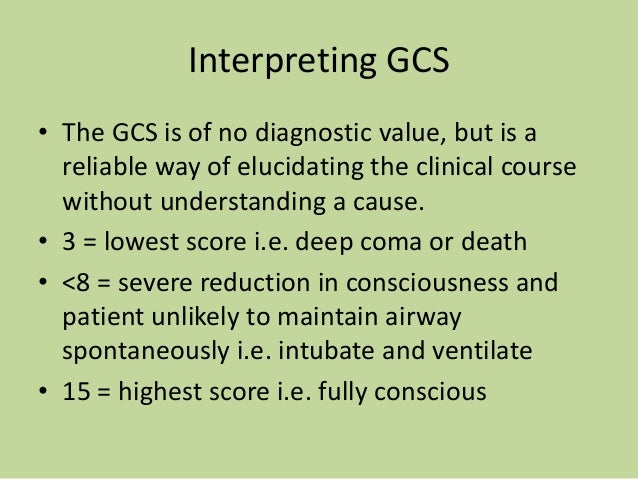


Assessment Of An Unconscious Comatose Patient



Glasgow Coma Scale Gcs Sketchy Medicine



0 件のコメント:
コメントを投稿